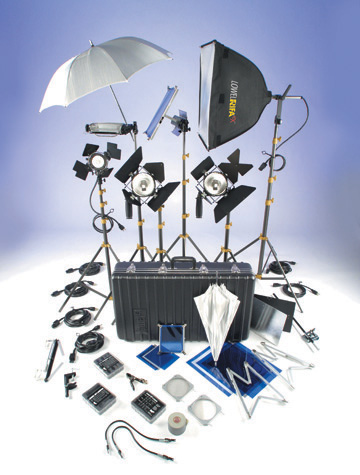|
EQUIPMENT Adapted from Brian Fitt's Lighting Technology written in 2002, he categorizes ten types of lights as summarized below. Fresnel - The Fresnel luminaire has a Fresnel lens and circular reflector with a light source placed at the centre of the radius of the reflector; lights with a soft edge keylight and used as a main illumination on large areas such as theatre lighting. PC – Plano convex lens is similar to the Fresnel in construction and performance. It is mainly used in theatre and has a beam appearance of an out of focus profile. It has a well defined soft edge to beam and does not produce spill light that falls onto other parts of the set. Disadvantages include the image of the filament in full spot and a dark hole in the centre of the beam between full flood and full spot positions; some manufactures provide diffusion on rear surface of lens to reduce both problems. Follow spots – The optics of the Follow Spot is the same as a Profile projector and iris diaphragm; it has the effect of dimming light without changing the colour temperature or the shape of the spot. This is a desirable feature for normal control and is useful when balancing the light on stage from two spots at different distances. Advantages are that the follow spot maintains a constant focus on a moving artist, however the disadvantage of a low angle follow spot without other illumination is a lack of field depth. Floodlight – Floodlights produce wide angles of illumination and cannot be controlled. The beam will not provide a cut off and spills due to the large area of the source and reflected light. Usually used as working lights as they are efficient and usually low in cost, small in size and weight. Softlight – A Softlight refers to the shadow definition implying that the edge of the shadow bleeds without a defined edge. The ultimate softlight would be light that approaches from a very large angle so that no shadows will appear, like north light. Thus, there is no such thing as a small soft light; and the large size of reflectors allow for softer shadows, so that compromise exists between the largest tolerable size. It is mainly used to as a fill light for the shadows created by the key light without creating more shadow. Focusing reflector light – A famous name for this is the "redhead" that describes the colour of the housing. It has a high light output from a small unit and has the ability to focus the beam but it also creates hard shadows and has a safety glass mesh built-in for safety reasons. Beam light- A centered light source with a parabolic reflector produces a parallel beam of light that creates a long beam. Its common use is in large theatres due to its high efficiency and narrow beam required for lights positioned a long distance from the stage and has very little spill light. The main disadvantage of a beam light is that the beam angle cannot be increased to a great extent by focusing and requires a transformer in the main supply line. This type of light has also been used for many years in lighthouses and searchlights. Sealed beam and PAR lights – this light employs the same optics as the beam light but replaces the front reflector with a moulded lens that controls the beam to a predetermined angle. The lamp is completely sealed and can run at high pressure and consequently provide high efficiency; the manufacture usually provides the choice of five beam angles. It is small, low cost and light weight, thus commonly used on 'pop' rigs. These are one of the only luminaires that cost less than the lamp that it is used in. Cyclorama/Backing light – These lights are made up of a series of lights and can be in these types of configurations; single, double and triple units, four lights in a line with hinges that allow it to bend, and a four way unit in a grid. Colours are usually employed in a red/green/blue colour mix in addition to a clear compartment to desaturate the colours. These lights are designed to have a horizontal angle of distribution that determines the coverage and can be tested with the entire unit lit.
Luminaire checklist
|
|||||
| INTRODUCTION | LIGHTING | EQUIPMENT | FILM REVIEWS | CONCLUSIONS | |
WORKS CITED
c. Elaine Lui
